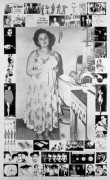 Jennifer Meeropol is the granddaughter of Ethel and Julius Rosenberg and the daughter of RFC Founder, Robert Meeropol. Jenn became the Executive Director of the RFC on September 1, 2013. Prior posts on this page were written by Robert (unless otherwise noted), and represent his opinions, which are not necessarily shared by the RFC.
Jennifer Meeropol is the granddaughter of Ethel and Julius Rosenberg and the daughter of RFC Founder, Robert Meeropol. Jenn became the Executive Director of the RFC on September 1, 2013. Prior posts on this page were written by Robert (unless otherwise noted), and represent his opinions, which are not necessarily shared by the RFC.News & Events
From the Executive Director
 Jennifer Meeropol is the granddaughter of Ethel and Julius Rosenberg and the daughter of RFC Founder, Robert Meeropol. Jenn became the Executive Director of the RFC on September 1, 2013. Prior posts on this page were written by Robert (unless otherwise noted), and represent his opinions, which are not necessarily shared by the RFC.
Jennifer Meeropol is the granddaughter of Ethel and Julius Rosenberg and the daughter of RFC Founder, Robert Meeropol. Jenn became the Executive Director of the RFC on September 1, 2013. Prior posts on this page were written by Robert (unless otherwise noted), and represent his opinions, which are not necessarily shared by the RFC.(Part 2 of the The RFC at 25 and Ethel Rosenberg at 100 series)
The first blog in this series explored the public response to the press conference my grandmother, Ethel Rosenberg, held in her kitchen in support of her husband, Julius Rosenberg, after his arrest in 1950. As I mentioned in my previous blog, an image of Ethel from that day is the centerpiece of "Unknown Secrets," a collage by Martha Rosler.* Numerous atomic images and anti-communists “frame” or surround Ethel in Rosler’s artwork.
(Guest post by Rosenberg Fund for Children founder, Robert Meeropol. Hear more from Robert about the iconic song, Strange Fruit, see its relevance to current Movement for Black Lives, and watch a powerful performance of it by artist Pamela Means, in the video below.)
(Part 1 of the The RFC at 25 and Ethel Rosenberg at 100 series)
What was the cultural context of Ethel’s trial and execution? The era of the 1950's was captivated by the idea of the housewife in her kitchen. This image was used to sell a multitude of products, to remind women of their proper place, and to reassure the war-weary populace that everything was back to normal and “cooking” again.
If she were still living, my grandmother, Ethel Rosenberg, would turn 100 on September 28th of this year.
I’ve always been an avid reader, especially of literary fiction. While I enjoy escaping into a fun novel, most of my favorite books are anything but frivolous reads. Instead, they tend to fall into the category of political fiction, exploring how people deal with forces that are often beyond their control and require them to confront dilemmas with no easy solutions.


